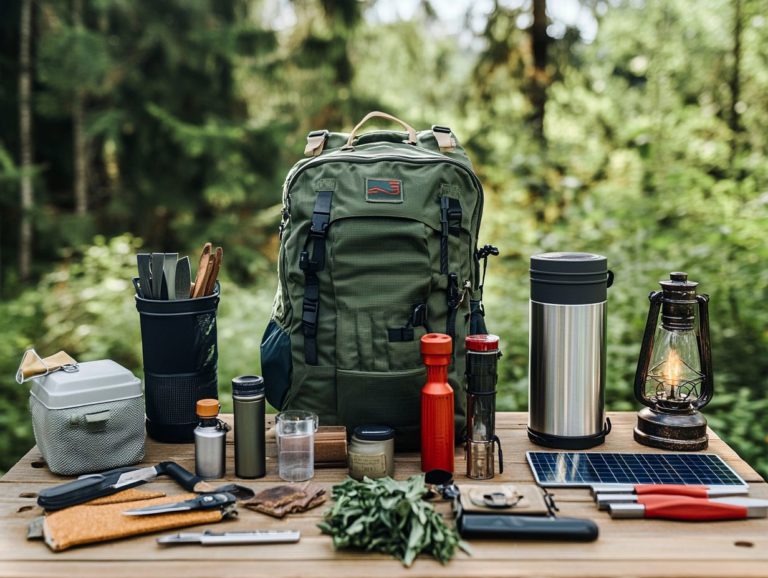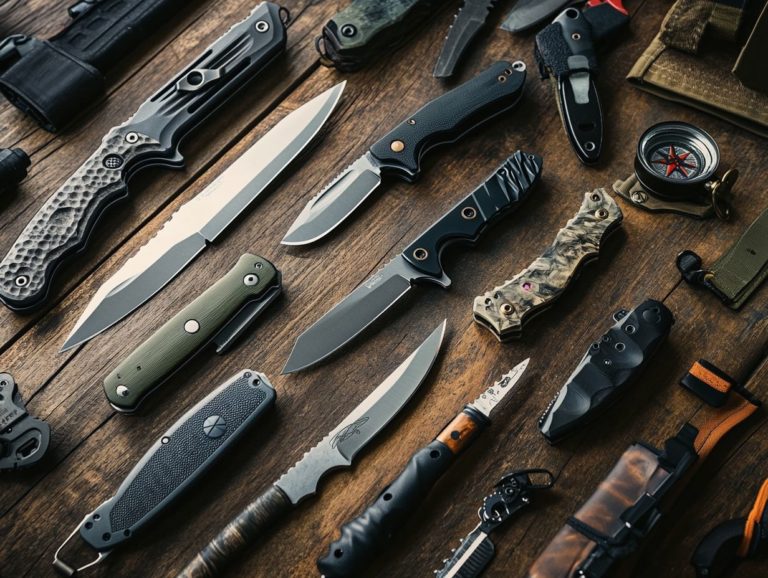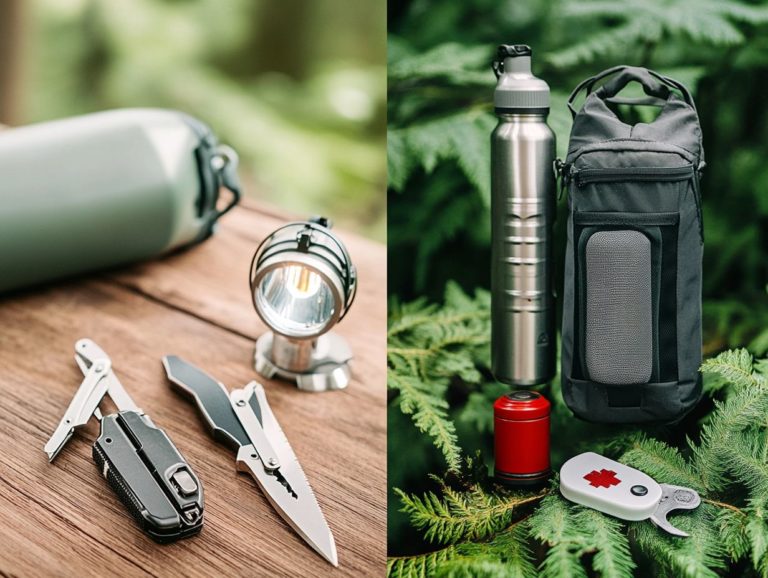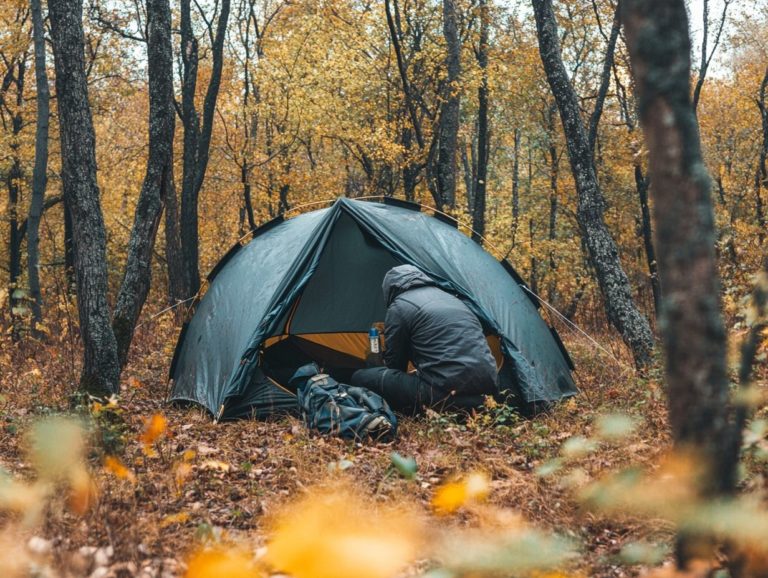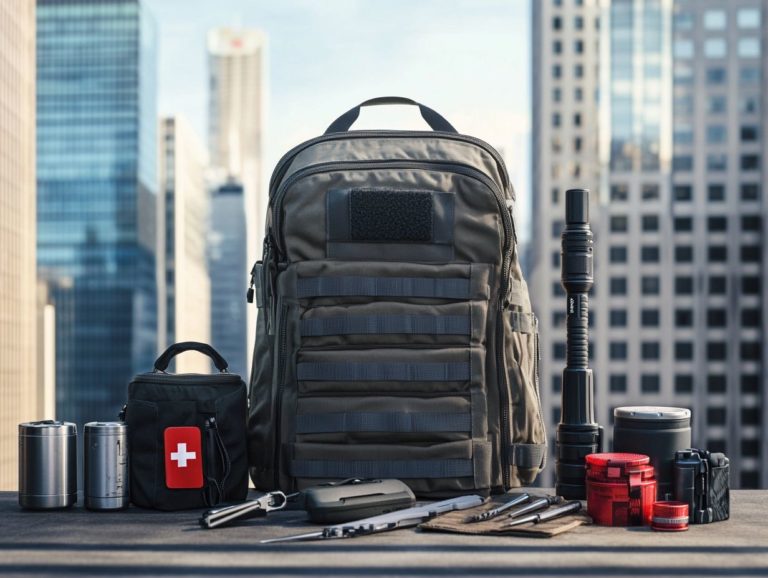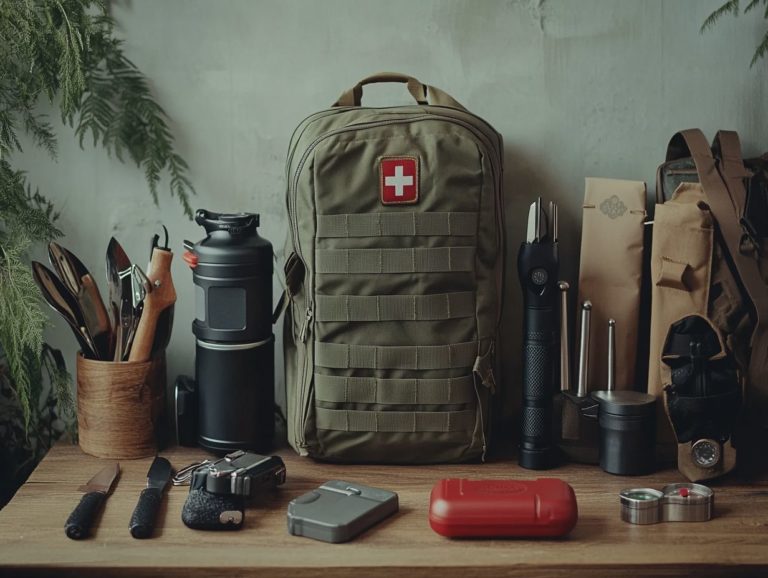Survival Gear for Long-Term Outdoor Living
Long-term outdoor living is an exhilarating journey, yet it presents its unique set of challenges. To thrive in the wilderness, gear up with the right survival tools that will empower you for adventure!
This guide will walk you through the essential items you need, covering everything from shelter and food supplies to navigation tools and first aid kits.
It also delves into key factors to keep in mind when selecting gear and offers insights on how to prepare effectively for an extended stay in the great outdoors.
Equip yourself with the knowledge to master the wilderness and embrace the adventure that awaits!
Contents
- Key Takeaways:
- What is Long-Term Outdoor Living?
- Essential Survival Gear for Outdoor Living
- Factors to Consider When Choosing Survival Gear
- Preparing for Long-Term Outdoor Living
- Frequently Asked Questions
- What is survival gear for long-term outdoor living?
- Why is it important to have survival gear for long-term outdoor living?
- What are some essential items to have in a survival gear kit for long-term outdoor living?
- How can I choose the best survival gear for long-term outdoor living?
- Is it possible to survive in the wilderness with just basic survival gear for long-term outdoor living?
- Can I make my own survival gear for long-term outdoor living?
Key Takeaways:
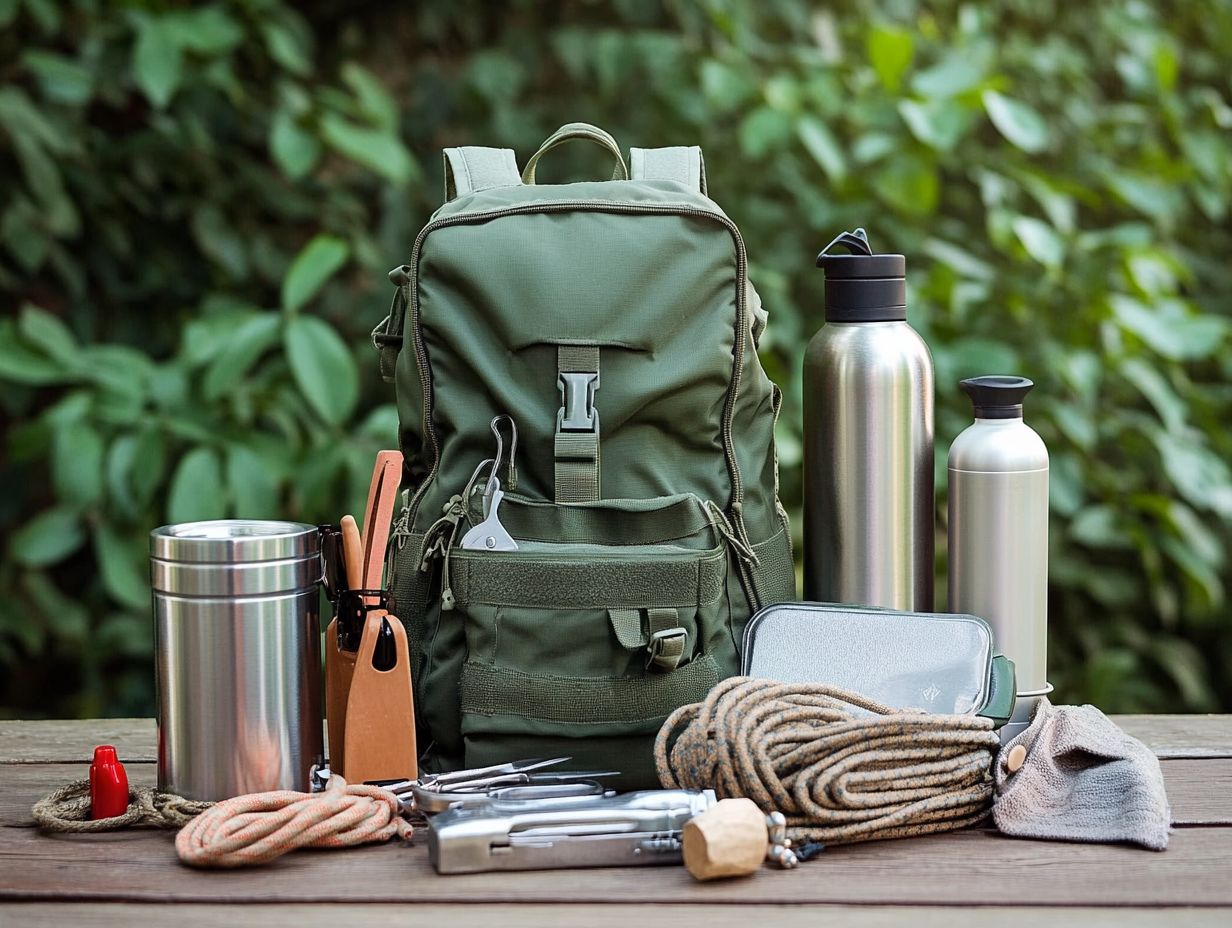
- Shelter and protection are essential for long-term outdoor living, so make sure to have a sturdy tent, sleeping bag, and other protective gear.
- Water and food supplies are crucial for survival, so pack enough for your needs and consider ways to purify water and search for edible plants.
- When choosing survival gear, consider the climate and terrain you will face, as well as your personal needs and preferences. Preparation and knowledge are key to successful long-term outdoor living.
What is Long-Term Outdoor Living?
Long-term outdoor living is about mastering the art of surviving and thriving in natural settings over extended periods. It emphasizes essential skills, strategies, and knowledge crucial for wilderness survival.
You’ll need to grasp survival priorities like shelter, water, food, and medical needs. All the while, adapt to the diverse scenarios that nature can throw your way. Embracing this lifestyle nurtures a profound connection with the natural world, highlighting self-sufficiency and resourcefulness—key traits for anyone aiming to excel in outdoor living and wilderness adventures, including understanding different types of survival gear.
Essential Survival Gear for Outdoor Living
Essential survival gear is critical for anyone venturing into long-term outdoor living, offering the necessary tools and equipment to guarantee your safety, comfort, and sustenance in the wild.
A well-stocked survival kit should encompass items that address your basic needs, including:
- fire-making gear like the exoTAC fireROD
- dependable water bottles
- effective purification methods such as Katadyn tablets
You’ll also want essential survival tools, like a fixed-blade knife from Benchmade and versatile cordage, such as 550 cord, to tackle various tasks. Don’t overlook signaling devices and emergency rations; these are critical for navigating and sustaining yourself through any survival scenario. For more tips, check out our guide on survival gear for urban environments.
Shelter and Protection
Start by building a waterproof shelter your first line of defense! It not only protects you from the elements but also significantly enhances your chances of long-term survival outdoors.
You can construct various types of shelters, such as tarps stretched between trees, debris huts crafted from natural materials, or even improvised structures using plastic sheeting. Utilizing flexible materials like plastic sheeting is particularly advantageous; they are lightweight and can be easily shaped to form a robust barrier against rain.
Focus on sealing any gaps and ensuring the shelter’s base is elevated to prevent water accumulation. By employing skills such as knot tying for secure fittings and overlapping layers for added waterproofing, you can greatly improve the reliability of these structures. This level of preparation offers not only functionality but also peace of mind in critical situations.
Water and Food Supplies
Water and food supplies are essential parts of your survival kit, directly influencing both your hydration needs and overall survival capabilities in the wild.
Access to clean water is critical, which is why efficient purification methods, like the MSR Guardian system, should be on your radar. This advanced filtration technology doesn t just eliminate harmful pathogens; it offers a trustworthy solution when emergencies arise.
In terms of sourcing food in wild environments, searching for edible plants and familiarizing yourself with local options become critical skills. Pair this knowledge with emergency rations as part of your survival gear.
By adopting this strategic approach to food procurement, you enhance your ability to maintain energy levels during unexpected challenges. Ultimately, this improves your chances of survival!
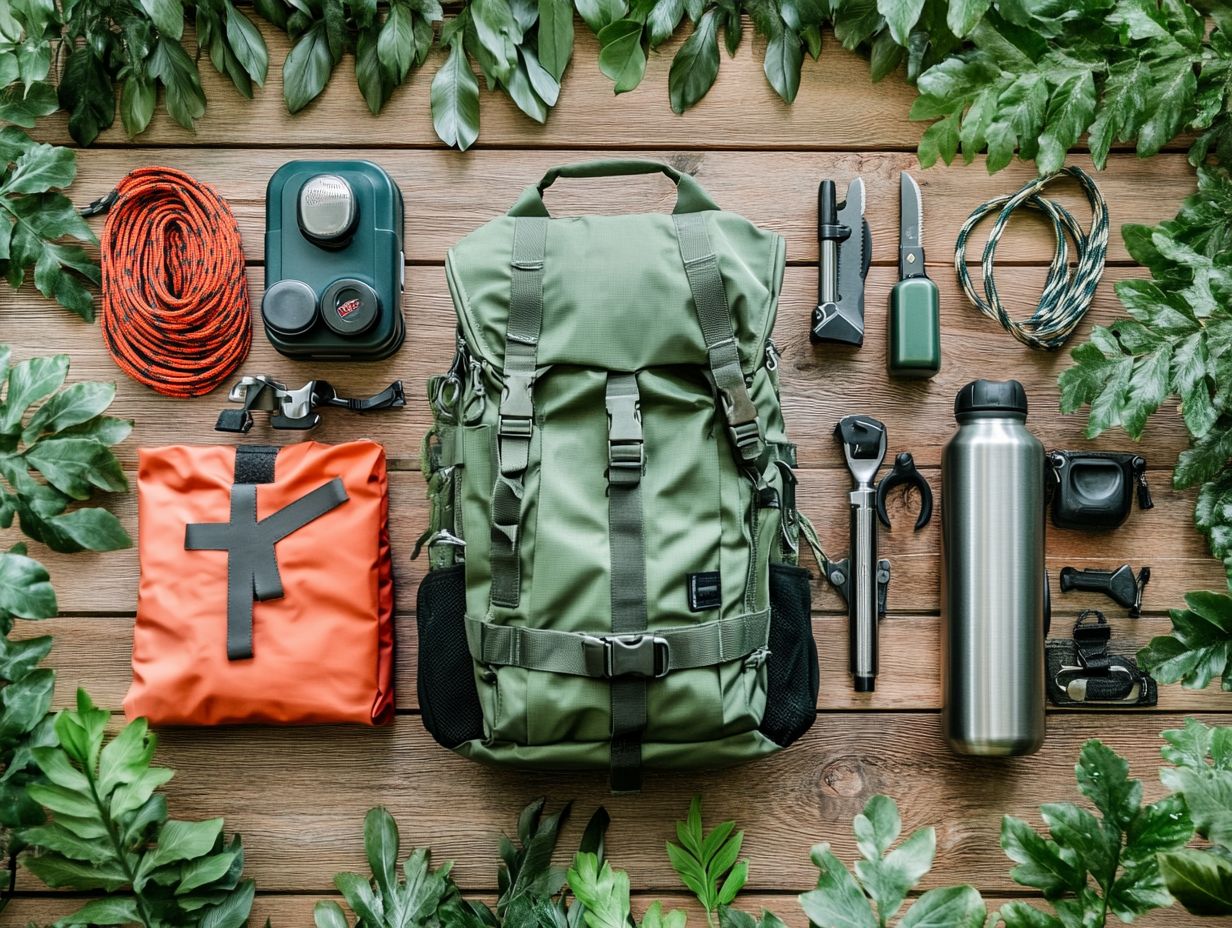
Navigation and communication tools are essential for ensuring your safety while exploring remote areas. They give you the ability to signal for help or find your way back during a wilderness adventure.
Employ various techniques such as reading maps, using compasses, or leveraging modern technology like the Garmin inReach Mini 2 to enhance your navigation skills. Traditional maps provide a comprehensive view of the terrain, while compasses deliver precise directional guidance. The Garmin device, equipped with GPS features, helps you pinpoint your location and allows you to send and receive messages and use emergency SOS signaling.
In challenging situations, use signaling devices like the ACR whistle and signal mirror. They can effectively draw attention and communicate your presence to rescuers, ensuring that your chances of survival remain high in critical moments.
First Aid and Medical Supplies
A well-stocked first aid kit is a critical element of your survival gear. It equips you with essential medical supplies to tackle injuries or health issues that may arise during wilderness adventures. This kit ensures you’re ready for everything from minor cuts and scrapes to more serious injuries.
Key components to include are:
- Use antiseptics to prevent infection.
- Have a variety of bandages, ranging from adhesive strips to larger gauze pads for significant wounds.
- Include essential medications like antihistamines for allergic reactions and pain relievers for discomfort.
Add items like tweezers for splinter removal, scissors for cutting tape or clothing, and thermal blankets for warmth to significantly boost your safety. Additionally, consider having the best cooking gear for survival situations on hand. Ultimately, preparing with the right gear fosters confidence and elevates your overall outdoor experience.
Fire and Cooking Tools
Fire and cooking tools are critical for warmth, cooking, and signaling for help. They are essential in any survival scenario.
In a survival situation, mastering various fire-starting methods can mean the difference between comfort and distress. For instance, Pyro Putty ignites a flame even in damp conditions, while the exoTAC fireROD offers a reliable, weatherproof spark that’s easy to use and carry. To enhance your preparedness, consider the top survival gear items for the wilderness. Together, these tools ensure you can start a fire quickly when it matters most.
To add versatility to your skill set, the MSR PocketRocket 2 stove is a must-have tool for every adventurous spirit. It helps you prepare meals swiftly.
These tools elevate your cooking in the wild and keep you safe.
Factors to Consider When Choosing Survival Gear
When choosing survival gear for outdoor living, it s crucial to consider factors like climate, terrain, and your individual needs. This consideration is key for your safety in the wild!
Climate and Terrain
Understanding the climate and terrain where you ll be living is essential for choosing the right survival gear and preparing for potential challenges.
If you’re heading into arid deserts, prepare for extreme temperature swings. Lightweight, breathable fabrics are a must for daytime wear, while insulated options are your best friends when nights turn chilly.
If you re hiking through rugged mountainous terrain, sturdy boots and breathable, waterproof layers are non-negotiable. They help you tackle sudden weather changes and lower the risk of hypothermia.
For those residing in tropical regions, high humidity and frequent rainfall call for quick-drying materials and dependable rain gear.
Every unique environment demands its own survival strategies, significantly shaping your choice of equipment. Choose your gear wisely to stay safe and efficient in any condition.
Personal Needs and Preferences
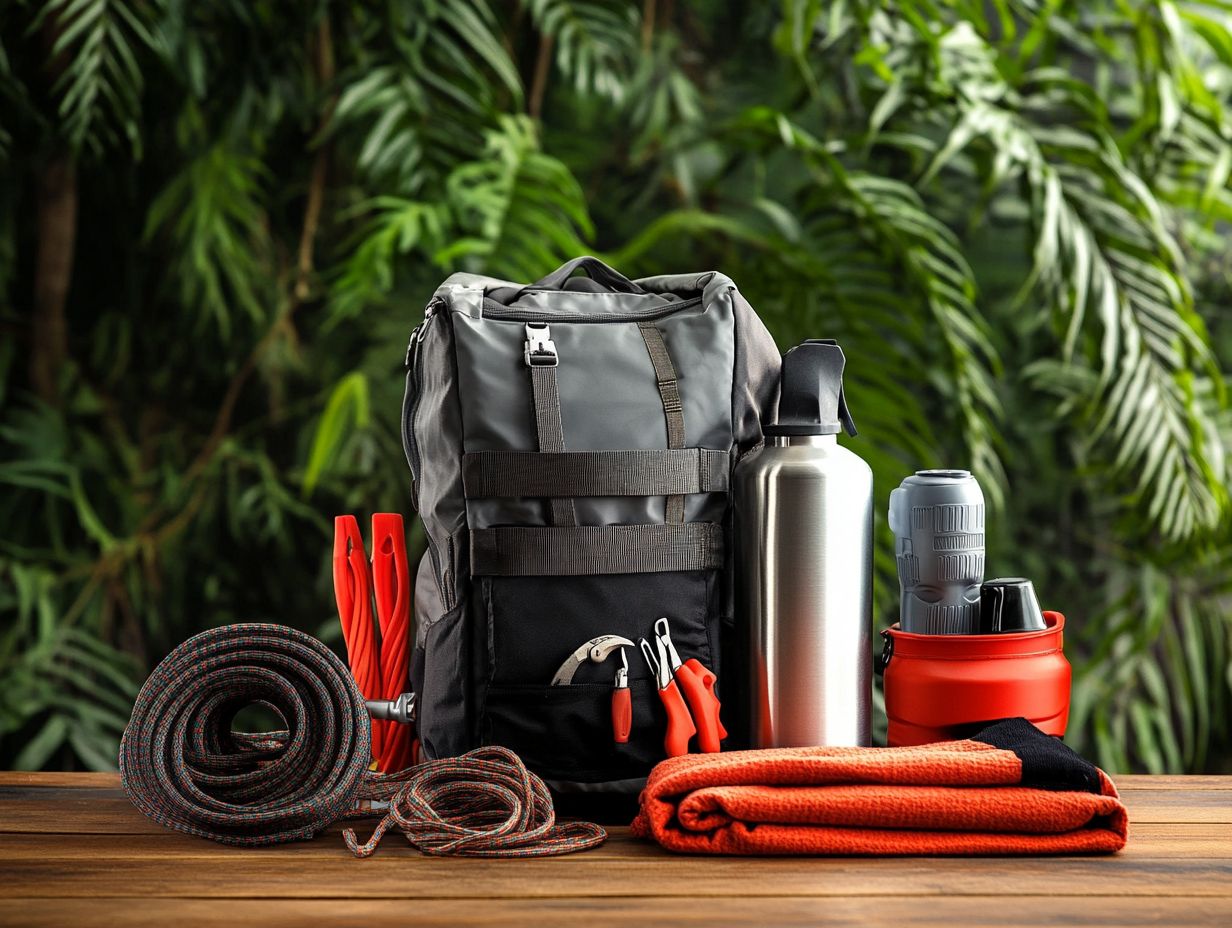
Your personal needs and preferences are essential for determining the specific items to include in your survival kit. This ensures it caters to your unique requirements and enhances your outdoor living experience.
To effectively assess these needs, consider your experience level with outdoor activities. This greatly influences the complexity of the items you might require. If you’re a beginner, prioritize essentials like water purification methods and basic first-aid supplies. For seasoned adventurers, investing in the best survival gear for backpackers may be essential, as they may seek more advanced tools tailored to their specific pursuits.
Consider your dietary restrictions. Include food options that match your needs, whether vegan, gluten-free, or otherwise. Comfort is another key aspect. Choose gear that aligns with your personal preferences, such as a favorite sleeping bag or preferred cooking method. This will significantly enhance your experience, ensuring that your survival kit is not just practical but also personally satisfying. Additionally, it’s important to be aware of the top features to look for in survival gear to ensure you’re fully prepared.
Preparing for Long-Term Outdoor Living
Preparing for long-term outdoor living requires a thorough approach that combines thorough training, knowledge acquisition, and practical preparations. This ensures you are fully equipped to navigate various survival scenarios with confidence and skill.
Training and Knowledge
Participating in wilderness classes and training programs is essential for acquiring the knowledge and skills needed for effective survival in outdoor environments. These educational experiences provide critical skills such as fire-making techniques, foraging for edible plants, and constructing shelters.
Wilderness survival courses immerse you in real-life scenarios that test your problem-solving abilities. Engaging in bushcraft projects not only deepens your connection with nature but also hones practical skills like tracking and primitive tool-making. Additionally, being prepared with the right survival gear for natural disasters is crucial for effective preparation.
Together, these training opportunities empower you to feel more self-reliant and confident. This ultimately strengthens your overall preparedness for any unexpected situations you might encounter in the wild.
Building a Survival Kit
Building a comprehensive survival kit is essential for anyone serious about long-term outdoor living. It consolidates all the vital gear and supplies you’ll need for emergencies.
This approach prepares you for surprises. It also brings peace while you explore the wilderness. Your survival kit is essential! Make sure it includes top survival tools for emergency preparedness:
- Pack a reliable multi-tool,
- Carry waterproof fire starters,
- Include a first aid kit,
- Bring navigation tools like a compass or map,
- and Wear suitable clothing layers to combat varying weather conditions.
When assembling your kit, consider your individual needs. Families might need to include extra supplies for children, while avid hikers may want to prioritize lightweight gear. Customization is crucial, so evaluating your personal circumstances and regional challenges can significantly enhance your readiness for unexpected situations. For those looking to prepare thoroughly, check out the top 10 survival gear for wilderness adventures.
Frequently Asked Questions
What is survival gear for long-term outdoor living?
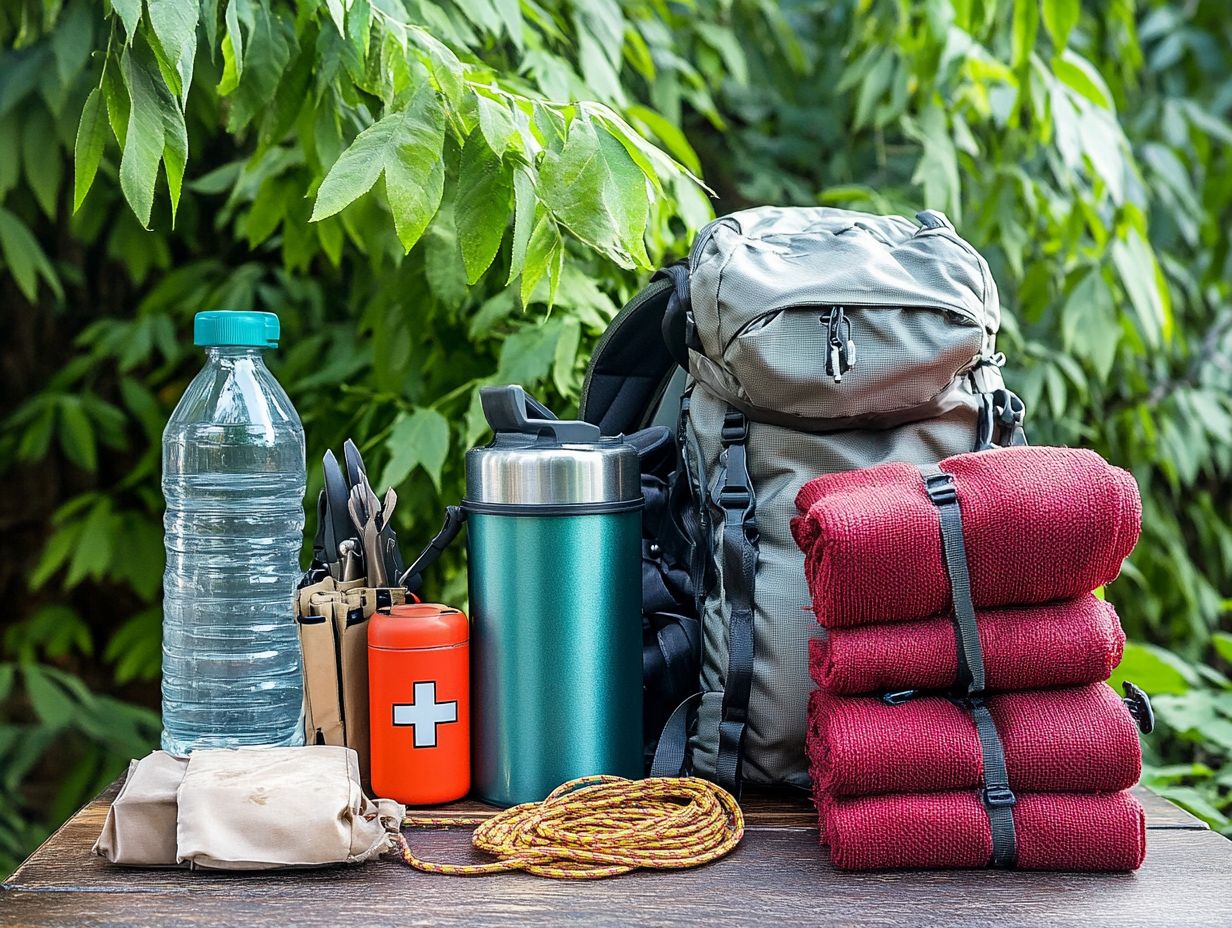
Survival gear for long-term outdoor living refers to equipment and tools specifically designed to help individuals survive in the wilderness for extended periods. These can include items such as shelter, food, water, and navigation tools.
Why is it important to have survival gear for long-term outdoor living?
Having survival gear for long-term outdoor living is crucial because it can mean the difference between life and death in a survival situation. These tools and supplies help individuals stay safe, find food and water, and survive until help arrives.
Start preparing your survival kit today to ensure you re ready for your next adventure!
What are some essential items to have in a survival gear kit for long-term outdoor living?
Get ready to face the wilderness! Essential items for a survival gear kit include a reliable shelter and a water filtration system. Don’t forget a fire starter, a multi-tool, a first aid kit, and a map with a compass for navigation.
How can I choose the best survival gear for long-term outdoor living?
To choose the best survival gear, start by researching and reading reviews from seasoned outdoorsmen. Think about the climate and environment you’ll face, and select gear that is strong and can be used in many situations.
Is it possible to survive in the wilderness with just basic survival gear for long-term outdoor living?
Yes, you can survive in the wilderness with basic survival gear. However, having advanced gear can make your experience safer and more comfortable.
Can I make my own survival gear for long-term outdoor living?
You can create your own survival gear. This option can save you money and allows for customization based on your specific needs.
Just ensure you have the necessary skills to create and effectively use your gear.

